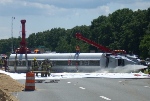
Case study: Emergency Response
Prompt Response to Overturned Petroleum Tanker Minimizes Impacts and Costs
- By Geoffrey Brown
- Nov 19, 2010
As the result of a multiple automobile accident on Rooute I-95 in northern coastal Massachusetts last summer, a bulk petroleum trailer tanker carrying approximately 10,200 gallons of gasoline overturned. This high-profile accident injured 10 people and closed the well-traveled interstate for several hours in both directions during a busy holiday weekend. The tanker released 8,600 gallons of petroleum into the surrounding area, causing the evacuation of a nearby neighborhood and home for developmentally disabled adults, as well as raising concerns for nearby wildlife and ecological areas.
The spilled gasoline mixed with water and fire suppressant foam applied by firefighters on the scene flowed along the slope of the highway into the associated storm drain system. The drain system discharges to the Merrimack River, located approximately one mile north of the accident scene. Thus, a short while after the accident, gasoline began to be discharged into the river.
The asphalt-paved roadway and soil surrounding the roadway also were significantly impacted by pollutants. Of particular concern were potential short-term vapor impacts to homes adjacent to the site, and longer term groundwater impacts to public drinking water wells located within one mile of the release.
The 10,200 gallons of spilled gasoline posed a variety of imminent environmental dangers, including those to air, surface water, groundwater, and soil. Airborne gasoline vapors are potentially explosive, due to the flammability of gas, and also can be acutely or chronically harmful to humans if inhaled. The gasoline constituents posed a toxic threat to the flora and fauna in the Merrimack River and also held the potential to be carried a long distance quickly through the tide and flow of the river. If gasoline constituents enter wells and are ingested, they may be toxic to animals and humans. Groundwater flow also can carry the contaminated particles long distances or introduce vapors into uninhabited structures. Those constituents may contaminant the soil and could impact to groundwater if not treated or removed.

Incidents involving the release of hazardous materials pose an imminent threat to the environment and public health. The overturned petroleum tanker accident required immediate response actions to control and clean up the scene.
Among those notified were local and regional police and fire responders, the Massachusetts Department of Environmental Protection, U.S. Environmental Protection Agency, the U.S. Coast Guard, and ENPRO Services, Inc., a locally based environmental cleanup firm experienced in hazardous waste remediation.
Emergency and Immediate Response Action (IRA) remediation activities were required as quickly as possible to contain and recover the gasoline and to remove and properly manage gasoline-impacted surface water, soil, and groundwater. ENPRO personnel and equipment arrived on the scene in less than 30 minutes, using a police escort to reach the site through miles of stopped traffic.
Emergency response actions involved product recovery, soil excavation, absorbent replacement, and cleaning of catch basins. The local Department of Public Works initially attempted to prevent the gasoline from entering the storm drain system by placing large sand piles near the impacted areas. However, due to the magnitude of the release, gasoline and gasoline-impacted water entered the drain system and were observed leaving the storm drain and entering the Merrimack River.
ENPRO inspected the stormwater structures leading from the release area to the outfall and pumped out any structures that exhibited gasoline impacts. Vacuum trucks were used to collect gasoline and gasoline-impacted water from the storm drain system, the roadway gutter, and the swale on the highway immediately below the overturned truck. The 25,000 gallons of impacted water recovered via the vacuum trucks were off-loaded into a tank for temporary storage and transported to ENPRO Services of Maine, Inc. in South Portland for proper disposal. To contain gasoline spilled into the river, ENPRO deployed several layers of harbor boom from the south bank of the river to the closest bridge pier using multiple water craft.
To address soil contamination, ENPRO personnel deployed absorbents over the release area and initiated excavation of the gasoline-impacted soil. The field team used an excavator to remove a total of 3,000 tons of gasoline-impacted soil from the release area. For two weeks, ENPRO transported the contaminated soil and sand to Aggregate Recycling Corporation in Eliot, Maine, for disposal.
The conditions indicating the need for the IRA were alleviated and all clean-up efforts were completed within two-and-a-half weeks of the release. Actions by emergency and environmental responders seamlessly and efficiently stabilized site conditions, and strong relationships between ENPRO, critical contractors, and local and state agencies allowed for rapid approvals and expedited cleanup actions including the highway closure, evacuations, drilling on city and state land, and excavation.
While long-term monitoring of the river and groundwater continue, the follow-up observational and analytical data indicate that the rapid, initial response actions successfully addressed the environmental impacts.
About the Author
Geoffrey A. Brown, Ph.D., is a vice president and has worked at ENPRO since 1998. Brown specializes in the assessment and remediation of complex oil and hazardous material release sites. He has more than 20 years of experience in the environmental field, with both environmental consulting/contracting firms and the Massachusetts Department of Environmental Protection. Brown holds a doctorate in soil science from Cornell University.